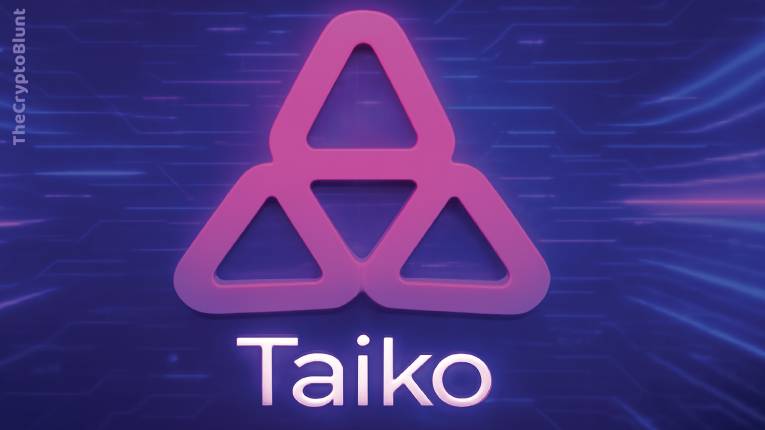That’s why I’m here to be your guide, to break down the fundamentals, explain how the broader crypto ecosystem functions, and then dive deep into a cutting-edge project: the Taiko Ecosystem. Taiko is at the forefront of solving some of the biggest challenges facing the most popular blockchain, Ethereum, aiming to make it faster, cheaper, and more broadly usable.
- Part 1: The Foundations of the Digital Economy – Understanding Cryptocurrency and Blockchain
- Part 2: Demystifying Common Crypto Misconceptions
- Part 3: Why Crypto Matters – Real-World Applications and Benefits
- Part 4: The Taiko Ecosystem – Scaling Ethereum with ZK-EVM Power
- Part 5: Getting Started in the Crypto World – A Beginner’s Perspective
This comprehensive guide is designed specifically for absolute beginners. We’ll cut through the jargon, tackle common misconceptions head-on, and show you why this technological revolution matters for everyone, not just tech enthusiasts or financial gurus. We believe in transparent education, providing you with accurate, well-researched information to help you navigate this exciting new frontier.
Let’s embark on this journey to understand the digital revolution, starting with the very basics.
Part 1: The Foundations of the Digital Economy – Understanding Cryptocurrency and Blockchain
Before we dive into the intricacies of the Taiko Ecosystem, it’s crucial to grasp the bedrock principles: cryptocurrency and blockchain. Think of them as the engine and the ledger of this new digital world.
What is Cryptocurrency? More Than Just Digital Money
At its simplest, cryptocurrency is a form of digital or virtual currency that uses cryptography for security. Unlike traditional currencies (like the Indian Rupee or US Dollar) issued and controlled by central banks, most cryptocurrencies are decentralized. This means they are not subject to government or financial institution interference.
Imagine a currency that lives purely online, secured by incredibly complex mathematical puzzles. That’s a cryptocurrency. Bitcoin, launched in 2009, was the first and remains the most well-known cryptocurrency. Since then, thousands of others have emerged, each with its own unique purpose and technology.
Key characteristics of cryptocurrencies:
- Digital: They exist only in digital form, not as physical coins or notes.
- Decentralized: No single entity controls them. Their operations are distributed across a network of computers.
- Secured by Cryptography: Advanced encryption techniques protect transactions and control the creation of new units.
- Peer-to-Peer: Transactions occur directly between users without intermediaries like banks.
- Immutable: Once a transaction is recorded, it cannot be altered or reversed.
Unpacking the Blockchain: The Transparent, Immutable Ledger
If cryptocurrency is the digital money, then blockchain is the revolutionary technology that underpins it. Think of a blockchain as a digital, public, and distributed ledger. Instead of a single bank keeping a record of all transactions, a blockchain shares this record across a vast network of computers worldwide.
The “block” in blockchain refers to batches of transactions. Once a block of transactions is verified, it is added to the “chain” of previous blocks, forming a continuous, chronological record. Each new block contains a cryptographic hash of the previous block, linking them together and making the chain incredibly secure and resistant to tampering. If someone tried to alter a transaction in an old block, it would invalidate all subsequent blocks, making the change immediately noticeable to the entire network.
(Consider adding an infographic here: A visual representation of blocks linked together, showing data and cryptographic hashes.)
Core principles of blockchain technology:
- Decentralization: No central authority manages the blockchain. The network of participants collectively maintains and validates it.
- Transparency: Every transaction ever recorded on the blockchain is visible to anyone on the network. While individual identities are often pseudonymized (represented by wallet addresses), the transaction data itself is public.
- Immutability: Once a transaction is added to the blockchain, it cannot be changed or removed. This creates an unchangeable historical record.
- Security: Cryptography ensures the integrity and authenticity of transactions and the overall ledger.
- Distributed Ledger Technology (DLT): The ledger is duplicated and shared across all participants in the network, making it highly resilient to failure.
Decentralization: The Power Shift
We’ve mentioned decentralization repeatedly, and for good reason. It’s a foundational concept that sets cryptocurrencies and blockchain apart from traditional financial systems.
In a centralized system, a single entity (like a bank, government, or corporation) holds all the power and control. They decide who can participate, what the rules are, and they maintain all the records.
In a decentralized system, control is distributed among all participants. There’s no single point of failure or control. This has profound implications:
- Increased Security: No single target for hackers to attack.
- Reduced Corruption: No single entity to bribe or coerce.
- Censorship Resistance: Transactions cannot be blocked or reversed by a central authority.
- Greater Accessibility: Anyone with an internet connection can participate, regardless of their location or financial status.
Mining: The Engine of the Blockchain
You might have heard the term “mining” in relation to cryptocurrencies like Bitcoin. It’s not about digging for gold! In the context of blockchain, mining refers to the process of validating and adding new transactions to the blockchain.
Miners are powerful computers (or networks of computers) that compete to solve complex mathematical puzzles. The first miner to solve the puzzle gets to add the next block of transactions to the blockchain and is rewarded with newly minted cryptocurrency and transaction fees. This process is called “Proof of Work” (PoW) and is how new coins are introduced into the system and how the network is secured.
It’s an energy-intensive process, but it’s crucial for maintaining the security and integrity of many decentralized blockchains. Other consensus mechanisms, like “Proof of Stake” (PoS), are also gaining prominence, offering more energy-efficient ways to secure blockchain networks.
Part 2: Demystifying Common Crypto Misconceptions
The rapid rise of cryptocurrencies has, understandably, been accompanied by a surge of misinformation and skepticism. Let’s tackle some of the most prevalent myths head-on, replacing fear with facts.
Misconception 1: “Cryptocurrency is only for criminals and illicit activities.”
This is perhaps the most persistent and damaging myth. While it’s true that, like any form of money (cash, gold, traditional banking), cryptocurrencies can be used for illicit activities, the vast majority of cryptocurrency transactions are legitimate.
The reality:
- Transparency of Blockchain: Unlike cash, which is anonymous, blockchain transactions are publicly recorded and traceable. Every transaction leaves a digital footprint. This makes it harder to conduct large-scale, untraceable illicit activities with crypto compared to traditional banking systems, where money can be laundered through complex shell corporations.
- Law Enforcement Adaptation: Law enforcement agencies worldwide are increasingly sophisticated at tracing crypto transactions and have successfully recovered billions in illicit funds.
- Growing Legitimate Use: Cryptocurrencies are being adopted by major companies for payments, used in international remittances, and are forming the backbone of new financial systems (DeFi). The sheer volume of legitimate transactions far outweighs illicit ones.
Misconception 2: “Cryptocurrency is a scam or a Ponzi scheme.”
The volatility of cryptocurrency prices and the emergence of fraudulent projects have led some to label the entire space as a scam. This is an oversimplification that ignores the underlying technology and its genuine utility.
The reality:
- Distinguish Technology from Scams: Blockchain technology itself is a legitimate and innovative invention with wide-ranging applications beyond just cryptocurrency.
- Investor Beware: Like any new and unregulated market, the crypto space has its share of bad actors and speculative bubbles. There have been Ponzi schemes and fraudulent projects that prey on unsuspecting investors. This highlights the importance of thorough research (Do Your Own Research – DYOR) and due diligence before investing in any project.
- Utility and Innovation: Many legitimate crypto projects are building real-world solutions, offering new financial services, revolutionizing data management, and creating new forms of digital ownership. These are not scams; they are technological innovations.
Misconception 3: “Cryptocurrency is bad for the environment.”
Concerns about the energy consumption of cryptocurrency mining, particularly Bitcoin’s Proof of Work mechanism, are valid and important. However, the narrative often oversimplifies the issue.
The reality:
- Evolving Energy Mix: While Bitcoin mining does consume significant energy, a growing portion of this energy comes from renewable sources. Miners are increasingly relocating to areas with abundant and cheap renewable energy (hydro, solar, wind) to reduce costs and improve sustainability.
- Efficiency Improvements: The industry is constantly innovating to improve energy efficiency. Newer consensus mechanisms like Proof of Stake (used by Ethereum 2.0 and many other blockchains) consume dramatically less energy than Proof of Work. Taiko, being a Layer 2 scaling solution for Ethereum, inherits Ethereum’s move to Proof of Stake, making it far more energy efficient than early Proof of Work chains.
- Comparison to Traditional Finance: The traditional financial system also has a massive carbon footprint, from vast data centers and ATMs to bank branches and employee commutes. It’s a complex comparison, but it’s important to consider both sides.
- Focus on Solutions: The focus should be on encouraging sustainable practices and the adoption of greener technologies within the crypto space, rather than dismissing the entire industry.
Misconception 4: “Cryptocurrency will replace all traditional money.”
While cryptocurrencies offer compelling advantages and are undoubtedly part of the future of finance, the idea that they will completely replace all traditional fiat currencies in the short to medium term is unrealistic.
The reality:
- Coexistence and Integration: It’s far more likely that cryptocurrencies will coexist with and integrate into traditional financial systems. We are already seeing this with institutional adoption, regulated crypto products, and central banks exploring their own digital currencies (CBDCs).
- Regulatory Landscape: Governments and central banks are still figuring out how to regulate cryptocurrencies. Full-scale replacement would require a fundamental shift in global economic policy and public trust.
- Accessibility and Adoption Hurdles: While growing, mass adoption of crypto still faces hurdles in terms of user-friendliness, scalability, and price volatility.
- Specialized Use Cases: Cryptocurrencies excel in specific use cases, such as international remittances, decentralized finance, and digital ownership, but traditional money still serves as the primary medium of exchange for most everyday transactions.
Part 3: Why Crypto Matters – Real-World Applications and Benefits
Beyond the hype and the technical jargon, why should you care about cryptocurrencies and blockchain? The answer lies in their ability to solve real problems and open up entirely new possibilities.
Faster, Cheaper International Payments
Imagine sending money across borders without exorbitant fees and long waiting times. Traditional international transfers can be slow and expensive due to multiple intermediaries (banks, SWIFT networks).
How crypto helps: Cryptocurrencies enable peer-to-peer international transfers that bypass these intermediaries. Transactions can settle in minutes, often for a fraction of the cost, making it a game-changer for remittances and global commerce. For instance, an immigrant sending money back home to their family can save significant amounts in fees.
Financial Inclusion: Banking the Unbanked
Globally, billions of people are “unbanked” or “underbanked,” meaning they lack access to basic financial services like bank accounts, loans, or credit. This often impacts individuals in developing nations or those without traditional identification.
How crypto helps: All you need to participate in the crypto ecosystem is a smartphone and internet access. This opens up financial opportunities for underserved populations, allowing them to store value, send and receive payments, and even access decentralized lending platforms, empowering them economically.
Decentralized Finance (DeFi): A New Financial System
DeFi is one of the most exciting and rapidly growing applications of blockchain technology. It refers to a collection of financial applications built on decentralized blockchains, primarily Ethereum. Think of it as a parallel financial system that operates without traditional intermediaries like banks, brokers, or exchanges.
What DeFi offers:
- Lending and Borrowing: Users can lend their crypto assets to earn interest or borrow assets by providing collateral, all without a bank.
- Decentralized Exchanges (DEXs): Trade cryptocurrencies directly with other users, without a centralized exchange holding your funds.
- Yield Farming: Put your crypto assets to work in various protocols to earn high returns.
- Stablecoins: Cryptocurrencies designed to maintain a stable value, often pegged to a fiat currency like the US Dollar, reducing volatility for everyday transactions.
DeFi offers greater transparency, accessibility, and potentially higher returns, but it also comes with its own set of risks, including smart contract vulnerabilities and high volatility.
(Consider adding an infographic here: A simple diagram showing how DeFi services like lending and borrowing work without a central bank.)
Non-Fungible Tokens (NFTs): Digital Ownership Redefined
NFTs are digital assets that represent ownership of unique items, whether it’s digital art, music, collectibles, or even virtual land. Unlike cryptocurrencies, which are “fungible” (one Bitcoin is interchangeable with another), each NFT is unique and cannot be replicated.
How NFTs matter:
- Digital Scarcity: NFTs create verifiable digital scarcity, allowing creators to monetize their digital work in new ways.
- New Revenue Streams: Artists, musicians, and content creators can sell their digital creations directly to fans, cutting out intermediaries.
- Verifiable Ownership: Blockchain technology ensures transparent and immutable proof of ownership for digital assets.
- Gaming and Metaverse: NFTs are crucial for the development of play-to-earn games and virtual worlds (the metaverse), where users can truly own in-game assets.
Supply Chain Management and Data Security
Beyond finance, blockchain’s immutability and transparency make it incredibly useful for tracking goods through supply chains, ensuring authenticity, and enhancing data security.
- Supply Chain: Companies can track products from origin to consumer, verifying their authenticity and preventing counterfeiting. This is especially useful for luxury goods, pharmaceuticals, and food products.
- Data Security: Blockchain can be used to create secure, tamper-proof records for sensitive data, from medical records to voting systems.
Part 4: The Taiko Ecosystem – Scaling Ethereum with ZK-EVM Power
Now that we have a solid understanding of the fundamentals, let’s dive into a project that is poised to play a crucial role in the future of the decentralized web: Taiko.
Ethereum, the blockchain that hosts most of the world’s decentralized applications (dApps), NFTs, and DeFi protocols, faces a significant challenge: scalability. As more users and applications join, the network can become congested, leading to slow transaction speeds and high “gas fees” (the cost of processing a transaction). This limits its widespread adoption.
Enter Layer 2 (L2) scaling solutions, which are built on top of the main Ethereum blockchain (Layer 1, or L1) to process transactions more efficiently off-chain before settling them back on L1. Taiko is a leading example of a specific type of L2 solution called a ZK-Rollup.
What is Taiko? A Type 1 ZK-EVM for Ethereum-Equivalent Scaling
Taiko is a decentralized, Ethereum-equivalent ZK-Rollup. Let’s break down what that means:
- ZK-Rollup: This is a powerful scaling technology. It works by “rolling up” (batching) thousands of transactions off-chain, processing them, and then generating a cryptographic proof (a “zero-knowledge proof” or ZKP) that verifies the correctness of all those transactions. This single, tiny proof is then submitted back to the Ethereum mainnet. Ethereum only needs to verify this one proof, rather than each individual transaction, dramatically increasing throughput and reducing costs.
- Ethereum-Equivalent (Type 1 ZK-EVM): This is where Taiko truly differentiates itself. The “EVM” stands for Ethereum Virtual Machine, which is the computational engine that powers Ethereum and executes smart contracts. A ZK-EVM is a Zero-Knowledge Ethereum Virtual Machine – it’s a system that can generate ZKPs for computations performed on the EVM.
- Type 1 ZK-EVM is the holy grail of ZK-EVMs. It means Taiko aims to be fully identical to Ethereum at the bytecode level. This is incredibly important because it means:
- Perfect Compatibility: Any smart contract or dApp that runs on Ethereum’s mainnet can run on Taiko without any modifications. Developers don’t need to learn new programming languages or tools.
- Seamless User Experience: Users interact with dApps on Taiko exactly as they would on Ethereum, making the transition virtually unnoticeable.
- Maximum Security Inheritance: Because Taiko’s execution environment is identical to Ethereum’s, it inherits the strongest security guarantees from the Ethereum mainnet.
- Type 1 ZK-EVM is the holy grail of ZK-EVMs. It means Taiko aims to be fully identical to Ethereum at the bytecode level. This is incredibly important because it means:
The native token within the Taiko ecosystem is TAIKO (TAI). It is used for transaction fees within the Taiko rollup and for governance.
How the Taiko Ecosystem Works: Proposers, Provers, and the L1
The Taiko ecosystem involves several key roles and components working together:
- Users: Individuals and dApps that submit transactions to the Taiko network.
- Proposers (Sequencers): These are network participants who collect user transactions from Taiko’s Layer 2, batch them into blocks, and propose these blocks to the Ethereum Layer 1 for verification. Taiko aims for decentralized proposers, meaning anyone can participate, which helps prevent censorship and increases resilience.
- Provers: These are the specialized computers that generate the complex zero-knowledge proofs for the proposed blocks. They verify that the computations and state changes within a block are correct according to Ethereum’s rules. Provers compete to be the first to submit a valid proof, earning rewards for their computational work.
- Ethereum Layer 1: This is the ultimate security layer. Once a proof from a Taiko block is submitted and verified on Ethereum L1, those transactions are considered final and immutable. This is why Taiko is said to “inherit” Ethereum’s security.
The Flow of a Transaction on Taiko:
- A user submits a transaction (e.g., a DeFi swap or an NFT mint) to the Taiko Layer 2 network.
- A decentralized Proposer picks up this transaction, bundles it with others, and creates a Taiko block. This block is then proposed (published) to Ethereum Layer 1.
- Provers compete to generate a valid zero-knowledge proof for this proposed block.
- Once a valid proof is generated and submitted to the Ethereum L1 smart contract, it’s verified. If correct, the state changes from the Taiko block are finalized on L1.
- This process ensures that transactions on Taiko are incredibly fast and cheap, while still retaining the high security and decentralization of Ethereum.
(Consider adding an infographic here: A diagram illustrating the flow from user transaction on Taiko L2, through proposers and provers, to finalization on Ethereum L1 via ZK-proofs.)
The Significance of a Type 1 ZK-EVM and “Based Rollup”
Taiko’s commitment to being a Type 1 ZK-EVM is a huge technical challenge but offers immense long-term benefits for the Ethereum ecosystem. It means that as Ethereum itself evolves, Taiko can easily adapt and remain fully compatible. It’s designed to be “the most native scaling solution for Ethereum.”
Furthermore, Taiko implements a “Based Rollup” design. This means that the ordering of transactions (sequencing) is ultimately performed by Ethereum Layer 1 validators. This is a crucial design choice that maximizes decentralization and censorship resistance, as it prevents any single centralized entity from controlling the order of transactions on Taiko. While this might have some trade-offs in terms of immediate transaction speed compared to some centralized sequencers, it firmly aligns Taiko with Ethereum’s core principles of decentralization and security.
Why Taiko Matters: Benefits and Use Cases
The unique characteristics of the Taiko Ecosystem offer several compelling advantages:
- Ethereum Scalability: Taiko directly addresses Ethereum’s scalability bottleneck, enabling the network to handle vastly more transactions per second (TPS) at significantly lower costs. This is crucial for mass adoption of dApps, DeFi, and the metaverse.
- Full Ethereum Compatibility: Developers can seamlessly migrate their existing dApps from Ethereum to Taiko or build new ones with their familiar tools and code, reducing development friction and accelerating innovation. This is a major advantage over L2s that require code modifications.
- Enhanced User Experience: Lower transaction fees and faster finality mean a smoother, more affordable experience for everyday users interacting with decentralized applications. Imagine sending a token or minting an NFT without worrying about prohibitive gas costs.
- Strong Security Guarantees: By leveraging ZK-Rollups and inheriting security directly from Ethereum’s Layer 1, Taiko offers a high degree of cryptographic security, protecting user funds and transaction integrity. The decentralized proposer and prover networks further enhance this security.
- Decentralization at Core: Taiko’s commitment to a decentralized sequencing model (Based Rollup) ensures that no single entity can control or censor transactions, upholding the core ethos of blockchain technology.
- Foundation for Web3 Innovation: By providing a highly scalable, secure, and compatible environment, Taiko serves as a robust platform for the next wave of Web3 innovation, from advanced DeFi protocols to immersive gaming experiences and decentralized social networks.
- Future-Proofing: As a Type 1 ZK-EVM, Taiko is designed to evolve with Ethereum, ensuring its long-term relevance and integration within the broader ecosystem.
Part 5: Getting Started in the Crypto World – A Beginner’s Perspective
So, you’ve grasped the basics, understood the benefits, and explored the powerful Taiko Ecosystem. Now, how do you actually get involved? This section provides a high-level overview without offering financial advice, as the crypto market is inherently volatile and carries risks.
1. Education is Key (You’re Already Doing It!)
Before anything else, continue learning. Read articles, watch educational videos, listen to podcasts, and understand the specific projects you’re interested in. Never invest in something you don’t understand. Given the technical nature of a project like Taiko, dedicating time to their official documentation and community channels is highly recommended.
2. Acquiring Cryptocurrency: Exchanges
The most common way to acquire cryptocurrency is through a cryptocurrency exchange. These platforms allow you to buy and sell cryptocurrencies using traditional fiat currency (like INR or USD) or other cryptocurrencies.
Types of Exchanges:
- Centralized Exchanges (CEXs): These are like traditional stock exchanges. They hold your funds (custodial) and offer a user-friendly interface. Examples include Binance, Coinbase, Kraken, and in India, platforms like CoinSwitch Kuber or WazirX. They are generally easier for beginners but come with the risk of holding your funds on the exchange. Many major exchanges list TAI (the native token of Taiko).
- Decentralized Exchanges (DEXs): These allow you to trade directly with other users without an intermediary. You retain control of your funds (non-custodial). Examples include Uniswap, which runs on Ethereum and its compatible Layer 2s like Taiko. DEXs are more complex for beginners but offer greater security and censorship resistance. You would likely use a DEX deployed on the Taiko network itself to interact with dApps there.
Choosing an Exchange: Consider factors like security, fees, available cryptocurrencies, user interface, and regulatory compliance in your region.
3. Storing Your Crypto: Wallets
Once you acquire crypto, you’ll need a wallet to store it. Think of a crypto wallet not as a place that holds your actual coins (which always remain on the blockchain), but as a tool that holds your “private keys” – the cryptographic codes that prove your ownership and allow you to access and manage your cryptocurrencies.
Types of Wallets for Taiko:
- Hot Wallets (Online): These are connected to the internet. They are convenient for frequent transactions but generally less secure than cold wallets.
- Exchange Wallets: Built into centralized exchanges. Easy to use but you don’t control the private keys.
- Software Wallets (Desktop/Mobile Apps): For Taiko, as it’s Ethereum-compatible, popular wallets like MetaMask are ideal. You can easily add the Taiko network to MetaMask and interact with dApps on it.
- Cold Wallets (Offline): These are not connected to the internet, making them highly secure.
- Hardware Wallets: Physical devices that store your private keys offline (e.g., Ledger, Trezor). Considered the most secure option for storing significant amounts of crypto. Many hardware wallets support Ethereum-compatible tokens and networks, including Taiko.
Crucial Advice: Keep Your Private Keys Safe! If you lose your private keys or they are stolen, you lose access to your crypto. Many wallets provide a “seed phrase” (a list of words) that can be used to recover your wallet if the device is lost. Guard this seed phrase with your life! Never share it with anyone, and store it offline in a secure location.
4. Using Your Crypto: Transactions and Beyond
Once you have crypto in your wallet, and especially if you’re interacting with the Taiko network, you can:
- Send and Receive: Transact directly with others on the Taiko network, benefiting from lower fees and faster speeds than Ethereum L1.
- Trade: Exchange TAI or other tokens on decentralized exchanges built on Taiko.
- Spend: As the Taiko ecosystem grows, more dApps and services will integrate with it, allowing you to use your crypto within that environment.
- Participate in DeFi: Engage with DeFi protocols deployed on Taiko for lending, borrowing, and yield farming at reduced costs.
- Collect NFTs: Mint, buy, and sell NFTs on marketplaces operating on the Taiko network.
- Bridge Assets: If you have assets on Ethereum L1, you can use a bridge to transfer them to Taiko to benefit from the L2’s efficiencies.
Conclusion: Taiko – The Drumbeat of Ethereum’s Scaled Future
The Taiko Ecosystem stands as a powerful testament to the ongoing innovation within the blockchain space. By committing to a Type 1 ZK-EVM and a decentralized “Based Rollup” design, Taiko is not just building another Layer 2; it’s striving to be the most faithful and robust scaling solution for Ethereum. This commitment means that developers and users alike can expect a familiar, secure, and highly scalable environment that truly feels like an extension of Ethereum itself.
Taiko addresses the critical need for Ethereum to scale without compromising its core values of decentralization and security. This makes it a pivotal project for the mass adoption of decentralized applications, opening doors for broader participation in DeFi, NFTs, gaming, and the entire Web3 paradigm.
However, as with any cutting-edge technology, it’s crucial to approach the Taiko Ecosystem with diligence and a commitment to continuous learning. The crypto market is dynamic and inherently volatile, and while the potential is immense, so are the risks.
















